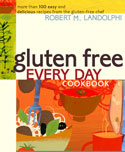Robert Landolphi
Chef and Author of
Gluten Free Every Day Cookbook
|
 |
Robert Landolphi's Featured Recipes from
Gluten Free Every Day Cookbook
Chocolate Chip–Banana Bread
 |
This is a favorite quick bread for many kids. The trick to making it highly moist and sweet is to use overripe bananas (the blacker, the sweeter.) If you don’t have time to make this bread when the bananas are prime, freeze them in their skins, then thaw, peel, and mash when you are ready to begin.
Ingredients:
- 1/2 cup chocolate chips
- 1/2 cup walnuts, chopped
- 1 cup white rice flour
- 1/4 cup brown rice flour
- 1/4 cup sorghum flour
- 1 teaspoon xanthan gum
- 1 teaspoon baking soda
- 1 teaspoon baking powder
- 1/4 teaspoon salt
- 1/2 cup (1 stick) unsalted butter, at room temperature
- 1 cup sugar
- 2 large eggs, beaten
- 1 1/2 teaspoons vanilla extract
- 1 cup mashed banana (about 2 medium bananas)
Instructions:
- Preheat the oven to 350°F. Butter a 9 by 5-inch loaf pan.
- In a small bowl, combine the chocolate chips and walnuts. Stir to mix. In a medium bowl, combine the white rice flour, brown rice flour, sorghum flour, xanthan gum, baking soda, baking powder and salt. Stir with a whisk to blend.
- Using an electric mixer on medium speed, cream the butter and sugar together until light and fluffy. Add the eggs and vanilla, beating until thoroughly incorporated, and then mix in the mashed banana. Gradually beat in the dry ingredients until a smooth batter forms.
- Pour one-third of the batter into the prepared pan and sprinkle in half of the nut mixture, followed by another one-third of the batter. Sprinkle with remaining nut mixture and the remaining batter. Smooth the top and bake for 50 minutes, or until a toothpick inserted in the center of the bread comes out clean. Remove from the oven and let cool for 15 minutes on a wire rack. Unmold and cut into slices to serve. Makes one 9 by 5-inch loaf.
Chocolate Chip–Banana Muffins:
Fill 12 buttered muffin cups two-thirds full with the batter and bake for 25 to 30 minutes.
—From Gluten Free Every Day Cookbook by Robert M. Landolphi/Andrews McMeel Publishing
Crab Cakes with Rémoulade Sauce
My sister Dana (our family crab cake connoisseur) claims that these are as good as the ones in Maryland. The secret is to use sweet and tender fresh lump crabmeat.
Rémoulade sauce:
- 1 1/2 cups mayonnaise
- 1/2 cup Creole mustard
- 1 tablespoon Worcestershire sauce (see Note)
- 1 teaspoon hot sauce
- 1/4 cup finely chopped sweet onions
- 1/4 cup finely chopped green onions (including green parts)
- 1/4 cup finely chopped celery
- 3 tablespoons minced fresh flat-leaf parsley
- 4 cloves garlic, minced
- 1/2 tablespoon freshly squeezed lemon juice
- 1 teaspoon capers, chopped
- Salt and freshly ground black pepper
Crab cakes:
- 3 tablespoons mayonnaise
- 2 teaspoons Old Bay seasoning
- 2 teaspoons freshly squeezed lemon juice
- 2 teaspoons Dijon mustard
- 1 teaspoon Worcestershire sauce (see Note)
- 1 large egg, beaten
- 2 dashes hot sauce
- 1 pound fresh lump crabmeat, picked over for shell
- 1 cup gluten-free dried bread crumbs
- 1/3 cup chopped green onions (including green parts)
- 2 teaspoons minced fresh flat-leaf parsley
- Salt and freshly ground black pepper
- Canola oil, for panfrying
- Lemon wedges, for garnish
For the rémoulade sauce: In a medium bowl, whisk together all the ingredients except the salt and pepper. Season to taste with salt and pepper. Cover and refrigerate overnight or up to 3 days.
For the crab cakes: In a small bowl, whisk together the mayonnaise, Old Bay seasoning, lemon juice, Dijon mustard, Worcestershire, egg, and hot sauce until smooth; set aside.
In a medium bowl, combine the crabmeat, bread crumbs, green onions, and parsley. Add the mayonnaise mixture and toss lightly until blended. Season with salt and pepper. Form into twelve 2 1/2-inch-round patties about 1/2 inch thick. Place the crab cakes on a platter and refrigerate for 1 hour.
In a large sauté pan, heat 1/4 inch canola oil over medium-high heat. Add the crab cakes and cook until golden brown, 3 to 4 minutes on each side. Transfer to paper towels to drain. Serve with lemon wedges and rémoulade sauce. Serves 6.
Note:
Lea & Perrins Worcestershire sauce is gluten free.
—From Gluten Free Every Day Cookbook by Robert M. Landolphi/Andrews McMeel Publishing
After months of testing and tweaking, I finally developed this gluten-free pizza crust to the point of perfection. For me, the ultimate accolade was achieved when unsuspecting friends chose the gluten-free version as their favorite when this pizza was served with two “regular” pizzas ordered from our local pizza place. This will guarantee shouts of, “Mama Mia! Pizzeria!”
Ingredients:
- 1 cup warm water (110°F)
- 1 package active dry yeast
- 1 cup sorghum flour
- 1/2 cup brown rice flour
- 1/2 cup white rice flour
- 1/4 cup tapioca flour, plus extra for dusting
- 1/4 cup potato starch
- 1/4 cup golden milled flaxseeds (page 24)
- 1/4 cup cornstarch
- 3 tablespoons dry milk powder
- 1 tablespoon sugar
- 2 teaspoons xanthan gum
- 1/4 teaspoon salt
- 1/2 cup grated pecorino romano or Parmesan cheese
- 1/2 cup shredded mozzarella cheese
- 5 cloves garlic, roasted
- 2 tablespoons olive oil
- 1 large egg, lightly beaten
- Pizza sauce, cheese, and toppings, as desired
Instructions:
- In a small bowl, sprinkle the yeast over the warm water. In a food processor, combine the sorghum flour, brown rice flour, white rice flour, tapioca flour, potato starch, flaxseeds, cornstarch, milk powder, sugar, xanthan gum, salt, and pecorino and pulse until mixed. Blend in the mozzarella cheese and garlic, and then add the olive oil, egg, and yeast mixture, pulsing until a dough ball begins to form.
- Transfer the dough to a pastry board lightly floured with tapioca flour. Divide the dough in half and form each into a ball. Place each ball of dough in an oiled bowl, and turn the dough to coat with oil. Cover with a damp towel or plastic wrap, and let rise in a warm place for 1 hour, or until the dough springs back when touched.
- Preheat the oven to 500°F with a pizza stone on the bottom rack. Place a dough ball on the lightly floured (with tapioca flour) board and flatten the dough into a round, beginning in the center and working outward. Using a rolling pin, roll the dough from the center outward until the round is 12 inches in diameter. Roll and pinch the edges to make a rim. Lightly sprinkle a pizza peel or baking sheet with cornmeal and slowly slide it under the dough. Dough could also be rolled on a pizza peel, or formed into a pan.
- Spoon 1/3 cup sauce, 1/3 cup cheese, and the desired toppings on top of the crust. Try not to overload the pizza with toppings, or you will end up with a soggy pizza.
- Transfer the pizza to the oven by carefully sliding it off the peel or pan onto the pizza stone. Bake for 15 to 20 minutes, until the crust is crisp and the cheese is lightly golden brown. While the pizza is baking, prepare the second pizza crust, using the same method. Makes two 12-inch pizzas.
Pecorino Bread Sticks:
- Follow the instructions in the above recipe for preheating the oven and flattening the dough, but form the dough into an 8-inch square. Using a rolling pin, roll the dough to a 1/4-inch thickness. Using a knife, cut 1/2-inch-wide strips. Roll the dough into rounded sticks.
- Dust a pizza peel or baking sheet with cornmeal and place the sticks on the pan. Brush the sticks lightly with melted butter, and sprinkle with your choice of sesame seeds, poppy seeds, grated Parmesan cheese, or kosher salt. Cover with a dry towel and let rise for 1 hour, or until the dough springs back when touched.
- Gently slide the bread sticks off the peel or pan onto the pizza stone. Bake for 15 to 20 minutes, or until golden brown. Makes 2 dozen bread sticks.
Chef’s Tip:
A preheated pizza stone is the key to making a crisp crust. But if you don’t have one, simply bake the pizzas or bread sticks on a cornmeal-dusted baking sheet.
—From Gluten Free Every Day Cookbook by Robert M. Landolphi/Andrews McMeel Publishing
Polenta is a popular dish in Italy and other European countries. Restaurants usually prepare it in two different ways. A firm polenta is baked in the oven, like cornbread, and then grilled; a soft polenta, as in this recipe, is cooked on the stove top.
Ingredients:
- 2 tablespoons olive oil
- 1 tablespoon minced shallots
- 2 cloves garlic, minced
- 4 cups chicken stock or broth
- 1 cup milk
- 1 cup yellow gluten-free cornmeal
- 3/4 cup shredded smoked Gouda cheese
- Salt and freshly ground black pepper
Instructions:
In a medium saucepan, heat the oil over medium-high heat and sauté the shallots and garlic for 2 minutes. Add the chicken stock and milk and bring to a boil. Gradually whisk in cornmeal. Decrease the heat to medium and cook for 15 to 20 minutes, whisking frequently until the mixture is thick and creamy. Whisk in the cheese until melted and season to taste with salt and pepper. Serve at once. Serves 4 to 6.
Cheddar or Parmesan Polenta:
In place of smoked Gouda, try using 1 cup shredded sharp Cheddar, or 1 cup Parmesan cheese.
—From Gluten Free Every Day Cookbook by Robert M. Landolphi/Andrews McMeel Publishing
Interview with Marlisa Brown MS RD CDE CDN Creator of Gluten Free Easy and Author of Gluten-Free Hassle Free,
and
Robert Landolphi Chef, and Author of Gluten Free Every Day Cookbook
Question: Are you or a family member unable to eat gluten? If not what started your work with gluten-free cooking?
Answer: In 1996, I married a young, bright, enthusiastic woman and we began planning for a hopeful future and a large family. It soon became clear, however, that we were not completely in control of our destiny. While she was in graduate school, Angela’s health took a slow but progressive turn for the worse. After several months of fatigue, digestive symptoms and unexplained aches and pains, even more symptoms emerged: rashes, hair loss, peripheral neuropathies (tingling in fingers/toes), muscle weakness, numbness and pain, headaches, and then a complete shutdown of her reproductive system. Countless doctor visits with numerous specialists followed. Their diagnoses included Epstein Barr Syndrome, Chronic Fatigue Syndrome, undetectable Lyme Disease, adrenal dysfunction and multiple sclerosis, yet no tests were conclusive. Angela continued to work and to plod through each day, but she was beginning to forget what it felt like to be “well.” Some days were so bad that she opted to take out life insurance at the age of twenty nine. Instead of planning for a baby and decorating a nursery, we began contemplating her seemingly eventual funeral. After nearly three years of suffering, a family member sent us an article, detailing a digestive disorder called Celiac Disease. That started the ball rolling. Angela decided to give it a try. Day one without bread, pasta, cereal, pastries, cake, muffins, etc. wasn’t too bad, and so she began day two, similarly, with eggs and bacon for breakfast, chicken and carrots for lunch and grilled fish, baked potato and beans for dinner. As early as day two on the diet, the symptoms began disappearing. By days three and four, there was no going back… the headaches were gone, the numbness had ended, digestion was normal, fingernails began growing and her spirits were lifting. Within three months of no gluten, her gut and body were healing and the hormones that had shut down were beginning to be produced again. It became clear that Angela had adult onset celiac disease, and our hope of resuming normal life activities, and of one day having a family, were back on the horizon. It did, however, take nearly four years of strict adherence to the gluten-free lifestyle (along with the prayers of our priests and our friends) to finally conceive, but with no doctors and no drugs involved! And so, every day we revel in our beautiful, healthy young sons, Joseph Anthony and Andrew Robert. And thus, it was Angela’s return to good health after starting the gluten free lifestyle that prompted my work with gluten free cooking.
Question: Why did you decide to write Gluten Free Everyday?
Answer: After Angela’s clinical diagnosis, she became entirely committed to embracing the Gluten Free diet. However, I couldn’t help notice her wistful look when we passed by a bakery, or when various dishes like soups or pasta dishes arrived in a restaurant, or at Thanksgiving dinner when Grandma dished out the stuffing. Once in awhile I heard, “Gee, that banana bread smells great,” or “I wish I could have a bowl of clam chowder,” and , “Remember when I could eat chocolate cream pie?” And so, with a life-long love of cooking, a culinary arts degree from Johnson & Wales University and the desire to create good gluten -free meals and desserts to keep my wife healthy, I dove into experimenting. Using various combinations of chestnut, sorghum, tapioca, corn and rice flours, as well as many of the gluten-free products on the market today, I began to develop a repertoire of dishes that Angela could eat. The Gluten Free Every Day Cookbook is truly a labor of love: my love for culinary arts; my love for my wife and desire for her to stay healthy, strong and happy; and a deep and resounding love for our children. Perhaps our boys are the real inspiration, for without the existence of a gluten-free diet for their mother, they may never have been conceived.
Question: What is your biggest challenge in gluten-free cooking?
Answer: Whether one is baking, thickening soups or encrusting proteins, finding the perfect blends of gluten free flours and starches is always the greatest challenge. I often ask the students in my cooking class to describe what wheat-based flour tastes like to them. The response is always the same, “it tastes bland” or “it has no real taste.” Through my trials with gluten-free cooking, I discovered that many of these flours, when not blended in the proper proportion, can leave an “after taste” in the finished product. I also discovered that good gluten-free cooking often requires more seasoning to obtain the optimal flavor and quality. Thus, it is important to use spices, herbs, nuts/nut meals and fruits to incorporate layers of different flavors into many of the gluten-free dishes you decide to prepare.
Question: Where do you see the future with gluten-free cuisine?
Answer: For those with Celiac disease or other gluten intolerance, the prospect for a future filled with excellent gluten-free cuisine looks very good indeed! I predict that within a few years, most restaurants will have a number of gluten free options available to their customers; and “foodies” and manufacturers will continue to experiment and create new breads, bakery products, pasta dishes, soups , thickeners and fried items that are both delicious and gluten-free. I like to look at the university that I presently work for as a positive indicator for this trend. Ten years ago we had four persons diagnosed with Celiac disease on our meal plan. Now we have well over 50, which required us to think differently, and to come up with gluten-free options which we make available at every meal, and in every dining facility on campus. The foodservice industry is a competitive, customer service driven industry. Only those institutions that are willing to go above and beyond the mainstream diet, in order to meet the needs of all loyal customers, are likely to survive and thrive.
Question: Do you have any thoughts on substitutes for recipes that include filo dough and puffed pastry?
Answer: What I have done in the past, and found to be successful, is to add one or two eggs to my pie crust recipe. This combination makes for a lighter dough which works well for turnovers and pastries. When taking on a gluten-free baking challenge, the cook has got to think outside of the box and create a new version of a cherished recipe, that will be pleasing to and safe for all. One example of this would be in preparing “spanikopita,” a Greek spinach pie, made with spinach, onions, feta cheese, and dill. This mixture is layered in between sheets of filo dough, similar to a lasagna. I’ve found that when I use the pie crust dough, with an egg or two incorporated into it, I am able to make individual spinach pies similar to mini calzones or turnovers. This is much easier than trying to cut square pieces out of a baking pan, and makes for an excellent appetizer at this size.
Question: What is your favorite substitute for gluten-free breads?
Answer: Substitutes for bread can be challenging, but I have found that there are a few tasty options that fill the void. When it comes to sandwiches I love using the Whole Grain Ivory Teff wraps made by Sonoma. They fold without breaking, and when grilled they have a wonderful texture and flavor. They make for awesome chicken and cheese quesadillas. When It comes to dinner parties, I usually use my recipes for Parmesan popover bites, (which are a lot like a hot, buttery crescent roll), or flaky buttermilk biscuits. When these are served to guests, they never even think about plain old “bread.”
Robert Landolphi
Chef, and Author of Gluten Free Every Day Cookbook
Robert Landolphi is a 1991 graduate of Johnson & Wales University with a Bachelor of Arts Degree in Culinary Arts and Food Service Management. He also completed a Certified Culinary Arts Instructor program at Central Connecticut State University. Rob has enjoyed a variety of food related occupations including several years as a Wedding Coordinator/Banquet Manager at Glastonbury Hills Country Club, and owner and operator of the Sugar Shack Bakery in Storrs, Connecticut. He currently serves as a Certified Culinary Arts Instructor and the Culinary Operations Manager with the University of Connecticut. Rob is a member of The National Association of College and University Food Services, the American Culinary Federation, Slow Food International and the National Restaurant Association. Rob has entertained audiences all the country with his unique cooking style, personality, and down to earth, yet informative demonstrations.
Rob’s media credits include producing and hosting the “Mangia Radio” show, 91.7 FM-WHUS, and writer and host of a cooking show called “Food for the Journey.” He has appeared on the Food Network’s “How Do You Iron Chef?” promotion program while hosting the University of Connecticut’s Annual Culinary Olympics, and on the new cable food program “Boy Meets Still.” Rob has also appeared on CBS Sports and WTNH News programs. He has made guest appearances on numerous “Food Talk” radio programs, and has shared recipes and industry food trend information with many magazines and newspapers.
Rob is married and has two young sons. He was introduced to the gluten free lifestyle in the year 2000, when after a lengthy illness, his wife was finally diagnosed with celiac disease. Since that time he has made it a personal mission to create and perfect gluten free recipes which will satisfy even the harshest of critics, including those who do not NEED to be wheat and gluten free, but love his food anyway.
| Past Featured Authors/Chefs: | |||









